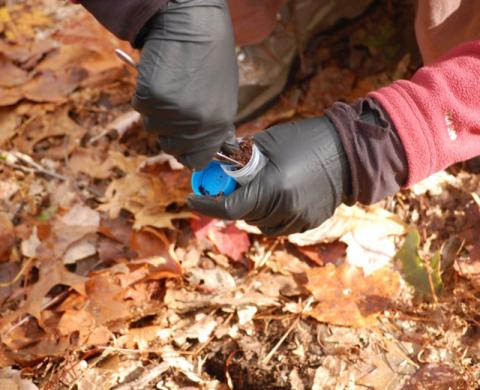Microorganisms make the world go ‘round. Well, that’s not strictly true—the world goes ‘round because of the gravitational pull of the sun. But, microorganisms—including bacteria, fungi, archaea, viruses, and protists—are responsible for cycling the Earth’s major elements ‘round.

Artwork by Elena Hartley (elabarts.com)
Just as microorganisms degrade sugars to make beer, or starch (simply a more complex sugar) to make sourdough bread, soil microbes transform carbon-based molecules into compounds delicious to the processes of the Earth system, including soil organic matter, plant available nitrogen, and respired gases like carbon dioxide and methane. These transformations are vital to planetary elemental cycling, because the first law of thermodynamics—that energy can’t be created or destroyed, merely transformed—holds true in ecosystems as well, and microbes are the Earth’s powerful, single-celled, energy-transforming machinery.
A teaspoon of soil has the surface area of a football field. Zooming in, we can look at the microscopic world where the soil biogeochemical and microbial processes that control ecosystem productivity, crop yields, and the global soil carbon cycle begin. It is a rugged terrain with sharp peaks and winding caverns, teeming with millions of microbes from thousands of species. Microbes compete and cooperate with one another and fall prey to soil animals including single-celled amoebae, worm-like nematodes, and tiny insects, many of whom also prey on one another. The apex predators of this intricate soil food web include arthropods no larger than a grain of rice.

All of these interactions between the microbes, larger organisms, and soil surfaces are happening at the scales of a nanometer or less. As we scale out from the truly microscopic to somewhat larger scales, these biogeochemical interactions between organisms and soil minerals are further influenced by the presence of plant roots and their special plant symbiotic fungi known as mycorrhizae. Plants pump carbon below ground where microbes can use it, hide it among the peaks and valleys or transfer it back to the atmosphere as greenhouse gases.
All of these interactions between the microbes, larger organisms, and soil surfaces are happening at the scales of a nanometer or less. As we scale out from the truly microscopic to somewhat larger scales, these biogeochemical interactions between organisms and soil minerals are further influenced by the presence of plant roots and their special plant symbiotic fungi known as mycorrhizae. Plants pump carbon below ground where microbes can use it, hide it among the peaks and valleys or transfer it back to the atmosphere as greenhouse gases.
